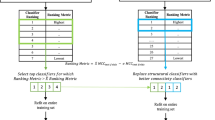Abstract
Magnetic resonance imaging (MRI) has emerged as an important tool to identify intermediate biomarkers of Alzheimer’s disease (AD) due to its ability to measure regional changes in the brain that are thought to reflect disease severity and progression. In this paper, we set out a novel pipeline that uses volumetric MRI data collected from different subjects as input and classifies them into one of three classes: AD, mild cognitive impairment (MCI) and cognitively normal (CN). Our pipeline consists of three stages—(1) a segmentation layer where brain MRI data is divided into clinically relevant regions; (2) a classification layer that uses relational learning algorithms to make pairwise predictions between the three classes; and (3) a combination layer that combines the results of the different classes to obtain the final classification. One of the key features of our proposed approach is that it allows for domain expert’s knowledge to guide the learning in all the layers. We evaluate our pipeline on 397 patients acquired from the Alzheimer’s Disease Neuroimaging Initiative and demonstrate that it obtains state-of-the-art performance with minimal feature engineering.





Similar content being viewed by others
References
http://prefrontal.org/blog/2008/05/brain-art-aal-patchwork. Accessed May 2012
http://www.slicer.org. Accessed May 2012
Blockeel H, De Raedt L (1998) Top-down induction of first-order logical decision trees. Artif Intell 101:285–297
Chen K, Reiman EM, Alexander GE, Bandy D, Renaut R, Crum WR, Fox NC, Rossor MN (2004) An automated algorithm for the computation of brain volume change from sequential mris using an iterative principal component analysis and its evaluation for the assessment of whole-brain atrophy rates in patients with probable Alzheimer’s disease. Neuroimage 22(1):134–143
Dempster AP, Laird NM, Rubin DB (1977) Maximum likelihood from incomplete data via the EM algorithm. J R Stat Soc 39:1–38
Dietterich TG, Ashenfelter A, Bulatov Y (2004) Training conditional random fields via gradient tree boosting. In: ICML 2004
Freund Y, Schapire R (1996) Experiments with a new boosting algorithm. In: ICML 1996
Friedman JH (2001) Greedy function approximation: a gradient boosting machine. Ann Stat 29:1189–1232
Galar M, Fernández A, Barrenechea E, Bustince H, Herrera F (2011) An overview of ensemble methods for binary classifiers in multi-class problems. Experimental study on one-vs-one and one-vs-all schemes. Pattern Recogn 44:1761–1776
Getoor L, Taskar B (2007) Introduction to statistical relational learning. MIT Press, Cambridge
Gutmann B, Kersting K (2006) TildeCRF: conditional random fields for logical sequences. In: ECML 2006
Hastie T, Tibshirani R (1998) Classification by pairwise coupling. In: NIPS, pp 507–513
Hastie T, Tibshirani R, Friedman J (2001) The elements of statistical learning. Springer, New York
Huang J, Ling LCX (2005) Using auc and accuracy in evaluating learning algorithms. IEEE Trans Knowl Data Eng 17(3):299–310
Karwath A, Kersting K, Landwehr N (2008) Boosting relational sequence alignments. In: ICDM 2008
Kersting K, Driessens K (2008) Non-parametric policy gradients: a unified treatment of propositional and relational domains. In: ICML 2008
Knerr S, Personnaz L, Dreyfus G (1990) Single-layer learning revisited: a stepwise procedure for building and training a neural network. In: Soulié F, Hérault J (eds) Neurocomputing: algorithms, architectures and applications, vol F68. Springer, Berlin, pp 41–50
Maldjian JA, Laurienti PJ, Kraft RA, Burdette JB (2003) An automated method for neuroanatomic and cytoarchitectonic atlas-based interrogation of fMRI data sets. NeuroImage 19(3):1233–1239
Natarajan S, Joshi S, Tadepalli P, Kristian K, Shavlik J (2011) Imitation learning in relational domains: a functional-gradient boosting approach. In: IJCAI 2011
Natarajan S, Khot T, Kersting K, Guttmann B, Shavlik J (2012) Gradient-based boosting for statistical relational learning: the relational dependency network case. Mach Learn 86(1):25–56
Sun L, Patel R, Liu J, Chen K, Wu T, Li J, Reiman E, Ye J (2009) Mining brain region connectivity for Alzheimer’s disease study via sparse inverse covariance estimation. In: KDD 2009
Supekar K, Menon V, Rubin D, Musen M, Greicius M D (2008) Network analysis of intrinsic functional brain connectivity in Alzheimer’s disease. PLoS Comput Biol 4(6):e1000100
Tang Y, Yan P, Yuan Y, Li X (2011) Single-image super-resolution via local learning. Int J Mach Learn Cybern 2(1):15–23
Xu X, Liu W, Venkatesh S (2012) An innovative face image enhancement based on principle component analysis. Int J Mach Learn Cybern 3(4):259–267
Ye J, Alexander G, Reiman E, Chen K, Wu T, Li J, Zhao Z, Patel R, Bae M, Janardan R et al (2008) Heterogeneous data fusion for alzheimer’s disease study. In: KDD p 1025
Acknowledgments
We would like to thank Ben Wagner for help with programming and creating the data set. SN acknowledges the support of Translational Science Institute of Wake Forest School of Medicine. KK was supported by the Fraunhofer ATTRACT fellowship STREAM.
Author information
Authors and Affiliations
Corresponding author
Rights and permissions
About this article
Cite this article
Natarajan, S., Saha, B., Joshi, S. et al. Relational learning helps in three-way classification of Alzheimer patients from structural magnetic resonance images of the brain. Int. J. Mach. Learn. & Cyber. 5, 659–669 (2014). https://doi.org/10.1007/s13042-013-0161-9
Received:
Accepted:
Published:
Issue Date:
DOI: https://doi.org/10.1007/s13042-013-0161-9




